高三一对一英语辅导方案-参考模板
一对一制定英语学习计划
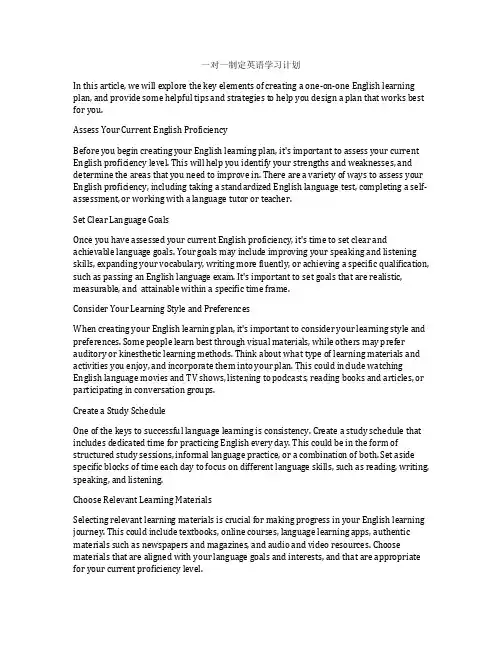
一对一制定英语学习计划In this article, we will explore the key elements of creating a one-on-one English learning plan, and provide some helpful tips and strategies to help you design a plan that works best for you.Assess Your Current English ProficiencyBefore you begin creating your English learning plan, it's important to assess your current English proficiency level. This will help you identify your strengths and weaknesses, and determine the areas that you need to improve in. There are a variety of ways to assess your English proficiency, including taking a standardized English language test, completing a self-assessment, or working with a language tutor or teacher.Set Clear Language GoalsOnce you have assessed your current English proficiency, it's time to set clear and achievable language goals. Your goals may include improving your speaking and listening skills, expanding your vocabulary, writing more fluently, or achieving a specific qualification, such as passing an English language exam. It's important to set goals that are realistic, measurable, and attainable within a specific time frame.Consider Your Learning Style and PreferencesWhen creating your English learning plan, it's important to consider your learning style and preferences. Some people learn best through visual materials, while others may prefer auditory or kinesthetic learning methods. Think about what type of learning materials and activities you enjoy, and incorporate them into your plan. This could include watching English language movies and TV shows, listening to podcasts, reading books and articles, or participating in conversation groups.Create a Study ScheduleOne of the keys to successful language learning is consistency. Create a study schedule that includes dedicated time for practicing English every day. This could be in the form of structured study sessions, informal language practice, or a combination of both. Set aside specific blocks of time each day to focus on different language skills, such as reading, writing, speaking, and listening.Choose Relevant Learning MaterialsSelecting relevant learning materials is crucial for making progress in your English learning journey. This could include textbooks, online courses, language learning apps, authentic materials such as newspapers and magazines, and audio and video resources. Choose materials that are aligned with your language goals and interests, and that are appropriate for your current proficiency level.Incorporate Language Practice Into Your Daily LifeIn addition to structured study sessions, it's important to incorporate language practice into your daily life. This could include engaging in conversation with native English speakers, writing in a journal, listening to English language music or podcasts, and practicing speaking and pronunciation. The more you immerse yourself in the language, the more natural and effortless your language skills will become.Seek Out Language Learning OpportunitiesLook for opportunities to practice English in real-life situations. This could include joining a language exchange program, participating in language meetups or conversation clubs, or finding a language tutor or conversation partner. By actively seeking out opportunities to use English in everyday life, you can improve your language skills and gain confidence in speaking and understanding the language.Keep Track of Your ProgressAs you work through your English learning plan, it's important to track your progress and celebrate your achievements. Keep a record of the new vocabulary you have learned, the grammar structures you have mastered, and the improvements you have made in your language skills. This will help you stay motivated and give you a sense of accomplishment as you reach each milestone.Regularly Review and Adjust Your PlanFinally, it's important to regularly review and adjust your English learning plan to ensure that it continues to meet your evolving needs and goals. As you progress in your language learning journey, you may find that certain activities are no longer as effective, or that you need to focus on different areas of language development. By reviewing and adjusting your plan as needed, you can stay on track to achieve your language goals.In conclusion, creating a personalized English learning plan can be a highly effective way to enhance your language skills and achieve your language goals. By assessing your current proficiency, setting clear goals, considering your learning style and preferences, creating a study schedule, choosing relevant learning materials, incorporating language practice into your daily life, seeking out language learning opportunities, keeping track of your progress, and regularly reviewing and adjusting your plan, you can create a comprehensive and effective plan that works best for you. With dedication, consistency, and the right resources, you can make significant progress in your English language learning journey.。
一对一英语学习计划
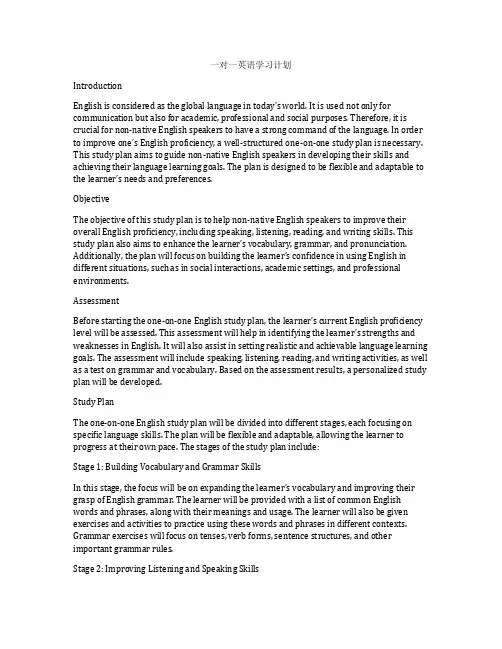
一对一英语学习计划IntroductionEnglish is considered as the global language in today’s world. It is used not only for communication but also for academic, professional and social purposes. Therefore, it is crucial for non-native English speakers to have a strong command of the language. In order to improve one’s English proficiency, a well-structured one-on-one study plan is necessary. This study plan aims to guide non-native English speakers in developing their skills and achieving their language learning goals. The plan is designed to be flexible and adaptable to the learner’s needs and preferences.ObjectiveThe objective of this study plan is to help non-native English speakers to improve their overall English proficiency, including speaking, listening, reading, and writing skills. This study plan also aims to enhance the learner’s vocabulary, grammar, and pronunciation. Additionally, the plan will focus on building the learner’s confidence in using English in different situations, such as in social interactions, academic settings, and professional environments.AssessmentBefore starting the one-on-one English study plan, the learner’s current English proficiency level will be assessed. This assessment will help in identifying the learner’s strengths and weaknesses in English. It will also assist in setting realistic and achievable language learning goals. The assessment will include speaking, listening, reading, and writing activities, as well as a test on grammar and vocabulary. Based on the assessment results, a personalized study plan will be developed.Study PlanThe one-on-one English study plan will be divided into different stages, each focusing on specific language skills. The plan will be flexible and adaptable, allowing the learner to progress at their own pace. The stages of the study plan include:Stage 1: Building Vocabulary and Grammar SkillsIn this stage, the focus will be on expanding the learner’s vocabulary and improving their grasp of English grammar. The learner will be provided with a list of common English words and phrases, along with their meanings and usage. The learner will also be given exercises and activities to practice using these words and phrases in different contexts. Grammar exercises will focus on tenses, verb forms, sentence structures, and other important grammar rules.Stage 2: Improving Listening and Speaking SkillsIn this stage, the learner will work on improving their listening and speaking skills. The learner will be provided with audio materials, such as recordings of conversations, interviews, and speeches. The learner will listen to these materials and practice understanding spoken English. The learner will also be given speaking activities, such as role-plays, discussions, and presentations, to develop their speaking skills. Feedback will be provided on pronunciation, intonation, and fluency.Stage 3: Enhancing Reading and Writing SkillsIn this stage, the focus will be on improving the learner’s reading and writing skills. The learner will be given a variety of reading materials, such as articles, essays, and short stories. The learner will read these materials and develop their reading comprehension skills. Writing activities will include tasks such as writing essays, emails, and reports. The learner will receive feedback on their writing, including grammar, vocabulary, and organization.Stage 4: Developing Communication SkillsIn this stage, the learner will focus on developing their communication skills in English. The learner will have the opportunity to engage in role-plays, simulations, and real-life conversations. The learner will practice communicating in different situations, such as making phone calls, giving presentations, and participating in meetings. The focus will be on building the learner’s confidence and fluency in using English for communication.Stage 5: Exam Preparation (if applicable)If the learner is preparing for a specific English exam, such as the TOEFL or IELTS, this stage will focus on exam preparation. The learner will be given practice tests and exam-style exercises to improve their test-taking skills. The learner will also receive guidance on the format and content of the exam, as well as tips for achieving a high score.Materials and ResourcesThe one-on-one English study plan will make use of a variety of materials and resources to support the learner’s language learning. These materials and resources may include: Textbooks and workbooksAudio and video materialsOnline learning platformsSample tests and examsInteractive language learning softwareOnline dictionaries and vocabulary toolsAdditional tutoring and supportThe learner will also be encouraged to take advantage of additional tutoring and support, such as attending language classes, hiring a private tutor, or joining language exchange programs. This additional support will provide the learner with opportunities to practice and improve their English skills in a supportive and interactive environment.Progress Tracking and FeedbackThroughout the one-on-one English study plan, th e learner’s progress will be tracked and monitored. Regular assessments and check-ins will be conducted to gauge the learner’s improvement in English proficiency. The learner will also receive ongoing feedback on their language skills, including areas of strength and areas for improvement. The learner will be encouraged to reflect on their progress and set new goals for further improvement.ConclusionThe one-on-one English study plan aims to provide non-native English speakers with a structured and effective approach to improving their English proficiency. This study plan is designed to be tailored to the learner’s individual needs and preferences, allowing for a personalized and flexible learning experience. By following this study plan, non-native English speakers can achieve their language learning goals and enhance their communication skills in English.。
高中英语一对一辅导
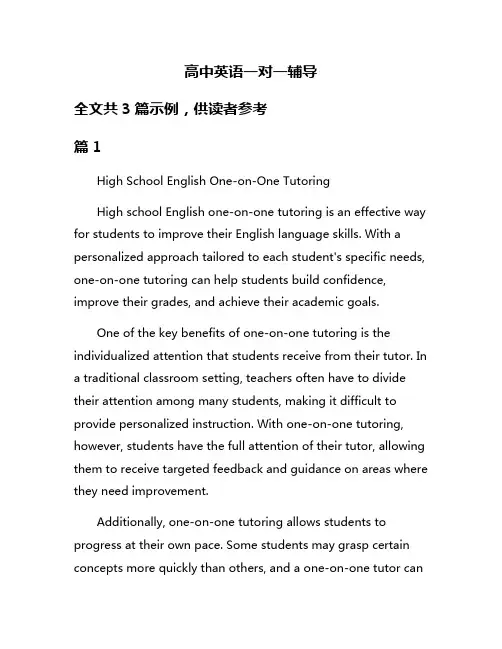
高中英语一对一辅导全文共3篇示例,供读者参考篇1High School English One-on-One TutoringHigh school English one-on-one tutoring is an effective way for students to improve their English language skills. With a personalized approach tailored to each student's specific needs, one-on-one tutoring can help students build confidence, improve their grades, and achieve their academic goals.One of the key benefits of one-on-one tutoring is the individualized attention that students receive from their tutor. In a traditional classroom setting, teachers often have to divide their attention among many students, making it difficult to provide personalized instruction. With one-on-one tutoring, however, students have the full attention of their tutor, allowing them to receive targeted feedback and guidance on areas where they need improvement.Additionally, one-on-one tutoring allows students to progress at their own pace. Some students may grasp certain concepts more quickly than others, and a one-on-one tutor canadapt their teaching style to match the student's learning speed. This personalized approach can help students build a strong foundation in English and develop the skills they need to succeed in their studies.Another advantage of one-on-one tutoring is the flexibility it offers. Students can schedule tutoring sessions at a time that works best for them, whether it's after school, on weekends, or during school breaks. This flexibility allows students to fit tutoring into their busy schedules and ensures that they receive the support they need to excel in their English studies.In addition to improving academic performance,one-on-one tutoring can also help students develop important study skills and strategies that will benefit them in all of their subjects. By working closely with a tutor, students can learn how to effectively manage their time, set goals, and study more efficiently. These skills can have a positive impact on students' academic performance and prepare them for success in higher education and beyond.Overall, high school English one-on-one tutoring is a valuable resource for students who want to improve their English language skills and achieve their academic goals. With personalized attention, flexible scheduling, and opportunities todevelop important study skills, one-on-one tutoring can help students build confidence, improve their grades, and succeed in their English studies.篇2High school students often face challenges in their English studies, whether it be difficulty understanding grammar rules, struggling with vocabulary, or feeling overwhelmed by the amount of reading and writing required. That's whereone-on-one tutoring can make a significant difference.One-on-one English tutoring offers personalized attention and tailored instruction to meet the unique needs of each student. Whether a student is looking to improve their grades, prepare for a standardized test, or enhance their overall language skills, a dedicated tutor can provide the support and guidance necessary for success.One of the key benefits of one-on-one English tutoring is the opportunity for students to work at their own pace. In a classroom setting, teachers often have to move quickly through the curriculum to keep up with the class schedule. This can leave some students feeling left behind or struggling to keep up. With one-on-one tutoring, students can take the time they need tomaster difficult concepts and build a solid foundation of understanding.Additionally, one-on-one tutoring allows for focused practice and feedback. Students can work on specific areas of weakness, such as grammar, vocabulary, reading comprehension, or writing skills, with the guidance of a knowledgeable tutor. Tutors can provide immediate feedback on assignments, correct errors, and offer strategies for improvement.Furthermore, one-on-one tutoring can help students build confidence in their English abilities. By working closely with a tutor in a supportive and encouraging environment, students can develop a growth mindset and a positive attitude towards learning. Success in English studies can lead to greater academic achievement, improved self-esteem, and increased motivation to continue learning and improving.In conclusion, one-on-one English tutoring can be a valuable resource for high school students seeking to improve their English skills. With personalized attention, tailored instruction, and focused practice, students can build a solid foundation of understanding, boost their confidence, and achieve academic success. If you are a high school student struggling with English,consider enrolling in one-on-one tutoring to receive the support and guidance you need to reach your full potential.篇3Title: High School English One-on-One TutoringIn today's competitive academic environment, many high school students are seeking additional support and guidance in their English studies. One way to address this need is through one-on-one tutoring. One-on-one tutoring offers personalized attention and instruction that can help students improve their English skills and achieve their academic goals.One of the key benefits of one-on-one tutoring is the individualized support that it provides. Unlike a traditional classroom setting where a teacher must cater to the needs of multiple students, a one-on-one tutor can tailor their lessons to meet the specific needs and learning styles of the student. This personalized approach allows the student to focus on areas where they need the most help, whether it be grammar, vocabulary, reading comprehension, or writing skills.Furthermore, one-on-one tutoring can help students build confidence in their English abilities. Many students struggle with English because they feel overwhelmed by the subject matter orlack the confidence to speak or write fluently. A one-on-one tutor can provide encouragement and positive reinforcement, helping the student overcome their fears and develop a more positive attitude towards learning English.Additionally, one-on-one tutoring can help students improve their English proficiency at a faster rate. With individualized instruction and focused practice, students can make rapid progress in their language skills. This can be especially beneficial for students who are preparing for standardized tests like the SAT or ACT, as a tutor can help them strengthen their reading, writing, and critical thinking skills in preparation for these exams.In conclusion, one-on-one tutoring can be a valuable resource for high school students who are looking to improve their English skills. By providing personalized attention, building confidence, and accelerating learning progress, one-on-one tutoring can help students achieve their academic goals and succeed in their English studies.。
英语一对一计划
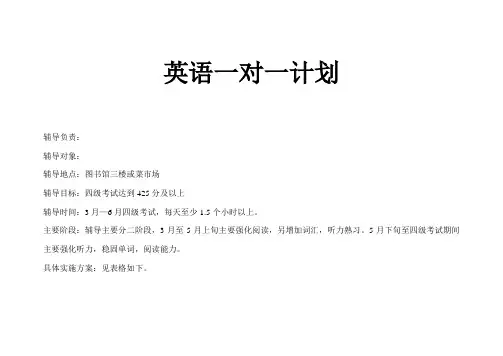
Part Two
快速阅读、仔细阅读各一篇
听力练习
快速阅读、仔细阅读各一篇
听力练习
作文练习
听力练习
周一
周二
周三
周四
周五
周六周日3月至来自月上旬Part One
听写10个新单词+10个旧单词
(以单词本一页为单位进行复习)
休息
Part Two
快速阅读、仔细阅读、Cloze各一篇
仔细阅读二篇,翻译
听力练习
快速阅读、仔细阅读、Cloze各一篇
仔细阅读二篇,翻译
听力练习
5月至四级考试
Part One
听写30个旧单词加强记忆
英语一对一计划
辅导负责:
辅导对象:
辅导地点:图书馆三楼或菜市场
辅导目标:四级考试达到425分及以上
辅导时间:3月—6月四级考试,每天至少1.5个小时以上。
主要阶段:辅导主要分二阶段,3月至5月上旬主要强化阅读,另增加词汇,听力熟习。5月下旬至四级考试期间主要强化听力,稳固单词,阅读能力。
具体实施方案:见表格如下。
英语一对一授课教案模板范文

课程名称:英语一对一辅导授课教师:[教师姓名]适用对象:[学生姓名]授课时间:[具体日期]授课时长:[时长,如60分钟]课程目标:1. 提升学生的英语听说读写能力。
2. 强化学生对英语语法和词汇的掌握。
3. 培养学生良好的英语学习习惯。
4. 增强学生的自信心,激发学习兴趣。
一、课前准备1. 教学资料:教材、练习册、多媒体课件等。
2. 学习工具:单词卡片、语法卡片、笔记本等。
3. 教学环境:安静、舒适的教室,准备一些英语学习相关的图片或视频。
二、教学流程1. 课前热身(5分钟)- 通过简单的英语问候和自我介绍,让学生放松心情,进入学习状态。
2. 词汇学习(10分钟)- 针对学生的词汇量,挑选合适的学习内容。
- 采用图片、例句等多种方式帮助学生记忆单词。
- 引导学生进行词汇拓展,提高词汇运用能力。
3. 语法讲解(15分钟)- 结合教材,讲解重点语法知识。
- 通过例句和练习题,让学生理解并掌握语法规则。
- 引导学生分析句子结构,提高语法运用能力。
4. 阅读训练(15分钟)- 选择适合学生水平的阅读材料。
- 指导学生阅读技巧,如快速阅读、细节理解等。
- 通过阅读练习,提高学生的阅读速度和理解能力。
5. 写作指导(15分钟)- 针对学生写作中存在的问题,进行针对性指导。
- 引导学生分析写作思路,提高写作水平。
- 提供范文,让学生模仿练习。
6. 听力训练(10分钟)- 播放英语听力材料,如对话、短文等。
- 指导学生听力技巧,如捕捉关键词、理解主旨等。
- 通过听力练习,提高学生的听力水平。
7. 课堂小结(5分钟)- 回顾本节课所学内容,巩固重点知识。
- 鼓励学生提出疑问,及时解答。
8. 课后作业布置(5分钟)- 布置适量课后作业,巩固所学知识。
- 鼓励学生在课后进行自主学习,提高英语水平。
三、教学评价1. 关注学生在课堂上的参与度,及时调整教学策略。
2. 定期进行课后作业检查,了解学生的学习情况。
3. 定期进行模拟考试,检验学生的学习成果。
英语一对一教学计划
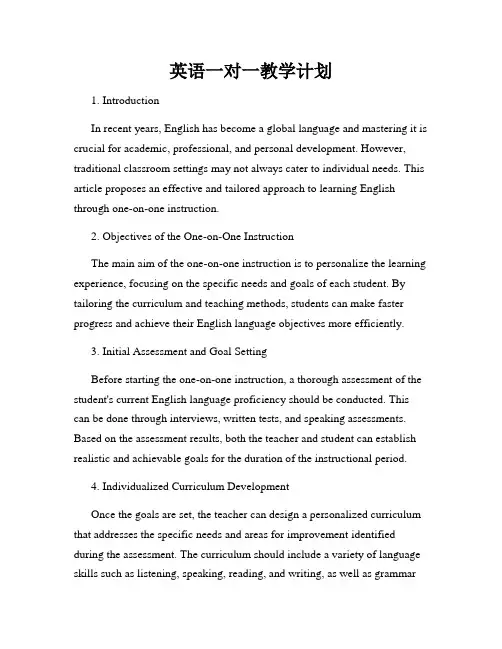
英语一对一教学计划1. IntroductionIn recent years, English has become a global language and mastering it is crucial for academic, professional, and personal development. However, traditional classroom settings may not always cater to individual needs. This article proposes an effective and tailored approach to learning English through one-on-one instruction.2. Objectives of the One-on-One InstructionThe main aim of the one-on-one instruction is to personalize the learning experience, focusing on the specific needs and goals of each student. By tailoring the curriculum and teaching methods, students can make faster progress and achieve their English language objectives more efficiently.3. Initial Assessment and Goal SettingBefore starting the one-on-one instruction, a thorough assessment of the student's current English language proficiency should be conducted. This can be done through interviews, written tests, and speaking assessments. Based on the assessment results, both the teacher and student can establish realistic and achievable goals for the duration of the instructional period.4. Individualized Curriculum DevelopmentOnce the goals are set, the teacher can design a personalized curriculum that addresses the specific needs and areas for improvement identified during the assessment. The curriculum should include a variety of language skills such as listening, speaking, reading, and writing, as well as grammarand vocabulary development. The teacher should also take into account the student's interests and learning preferences when planning the curriculum.5. Tailored Instructional MethodsOne-on-one instruction allows for the use of various teaching methods that suit the student's learning style. For auditory learners, listening exercises and recorded conversations can be effective. Visual learners may benefit from visual aids and graphic organizers. Kinesthetic learners can engage in role-plays and interactive activities. By adapting the instructional methods, the student can maximize their learning potential.6. Regular Progress EvaluationThroughout the instructional period, it is important to monitor the student's progress to ensure the effectiveness of the one-on-one instruction. This can be done through regular quizzes, assignments, and evaluations. By providing constructive feedback, the teacher can guide the student towards improvement and make any necessary adjustments to the curriculum or teaching methods.7. Flexibility and AdaptabilityOne of the main advantages of one-on-one instruction is its flexibility. The teacher can adapt the pace and content to cater to the student's specific needs and progress. If a particular area requires more attention or if the student is grasping concepts quickly, the teacher can modify the curriculum accordingly. This adaptability allows for optimal learning outcomes.8. Communication and SupportRegular communication between the teacher and student is vital for the success of the one-on-one instruction. The teacher should provide ongoing support and encouragement, addressing any concerns or difficulties the student may encounter. Additionally, the teacher can recommend supplementary learning resources such as online exercises, books, or language exchange programs to further enhance the student's progress.9. ConclusionThe one-on-one instructional approach offers a personalized and effective way of learning English. By tailoring the curriculum, methods, and support, students can make significant progress in their language skills. The flexibility and adaptability of this approach ensure that individual needs are met, leading to successful English language acquisition.。
英语一对一学习计划
英语一对一学习计划IntroductionLearning a new language can be a challenging yet rewarding experience. English is a global language, spoken by millions of people around the world. Mastering English can open up a world of opportunities for personal and professional growth. One-on-one English learning can be a great way to improve language skills in a personalized and effective way. In this learning plan, we will outline a comprehensive approach to one-on-one English learning, including setting goals, choosing effective learning materials, using technology to enhance learning, and developing a personalized study schedule.Setting goalsBefore beginning one-on-one English learning, it's important to set clear and achievable goals. These goals will help guide the learning process and ensure that progress is being made. Goals could include improving speaking, listening, reading, and writing skills, expanding vocabulary, mastering grammar and punctuation, or preparing for a specific exam or certification. It's also important to set a timeline for achieving these goals, whether it's a few months, a year, or more. Having a clear vision of what you want to achieve will help keep you motivated and focused throughout the learning process.Choosing materialsThere are a wide variety of resources available for English language learning, including textbooks, online courses, language exchange partners, language learning apps, and more. When choosing materials for one-on-one English learning, it's important to find resources that are tailored to your learning style and goals. For example, if your goal is to improve spoken English, you may want to focus on materials that include a lot of listening and speaking practice. If you're preparing for an English proficiency exam, you may want to invest in a comprehensive test preparation book or course. It's also important to choose materials that are at an appropriate level for your current language skills, as well as materials that cover a wide range of topics and themes to expand vocabulary and cultural knowledge.Using technologyTechnology can be an invaluable tool for one-on-one English learning. There are many apps, websites, and programs that can enhance language learning, including language learning apps, online dictionaries, grammar and vocabulary apps, language exchange websites, and more. These tools can provide additional practice, feedback, and resources to supplement one-on-one learning sessions. Additionally, technology can enable one-on-one students to engage in immersive language experiences, such as watching English-language movies and TV shows, listening to English-language music and podcasts, and participating in language exchange conversations with native speakers via video chat. These experiences can help improve listening comprehension, speaking fluency, and cultural knowledge.Developing a study scheduleConsistency and regular practice are key to successful language learning. When engaging in one-on-one English learning, it's important to develop a study schedule that allows for regular practice and review. This schedule should include dedicated time for individual study, such as vocabulary and grammar practice, as well as regular one-on-one sessions with a language tutor or partner. The schedule should be realistic and manageable, taking into account other commitments and responsibilities. It's also important to include a variety of activities in the study schedule, such as reading, writing, listening, speaking, and test practice, to ensure a well-rounded approach to language learning.ConclusionOne-on-one English learning can be a highly effective way to improve language skills in a personalized and focused manner. By setting clear goals, choosing effective materials, using technology to enhance learning, and developing a personalized study schedule, learners can make significant progress in their English language abilities. With dedication, perseverance, and the right support, one-on-one English learning can be a fulfilling and rewarding experience.。
针对高中生的一对一英语教学计划要点
针对高中生的一对一英语教学计划要点第一篇:针对高中生的一对一英语教学计划要点针对高中生的一对一英语教学计划要点类别:阅读来源:美联英语学习网对于很多人来说,高中那三年都是非常让人怀念的岁月。
当然,我们在高中的生活其实还是挺辛苦的,有很多人上完课,还要上一对一英语家教,所有的时间几乎都是花在学习上的。
大部分人对于高中时光都会有她怀念的地方,现在想起来会觉得其实那个时候并没有觉得十分的辛苦,但是如果你让大家重上一遍高中,应该很少人觉得很好了。
不过对于给高中生进行一对一英语教学的人来说,制定一个简单的教学计划还是有必要的。
下面我们就介绍一下一对一英语家教的教学计划有什么注意要点。
首先当然是要结合学生的实际,采取多种措施,注意培养学生对英语的兴趣;和良好的学习习惯。
充分调动学生的学习积极性和主动性。
其次最好坚持每周一次笔头训练,训练题材、方法力求多样化,并能及时进行讲评。
鼓励学生写英文日记,帮助他们养成学习英语的良好习惯。
在教学中要重视词汇教学,狠抓单词的记忆与巩固以及对词汇的意义与用法的掌握。
使学生掌握科学的单词记忆方法和养成勤查词典的习惯。
上面就是对于一对一英语老师指定教学计划的一点小的建议。
其实我们的教学计划也并不是说要真的跟时刻表一样每一样都列的十分清楚,但是我们要对自己的课程进度心里有数,找到适合学生的教学节奏,只有这样才是最好的。
第二篇:2015考研英语一对一教学计划2015考研英语一对一教学计划共30课时,22.5小时大致分三个阶段第一阶段:写作复习总论和纠错认识(学生作文)(预计1.5小时)这一阶段内容首先要让学生了解考研,认识考研的基本要求,教学目标:先对考研大纲写作知识点有全面的、具体的了解,了解写作考查目标,试卷结构,评分标准以及考生的优秀作文。
预习计划:上课前要适当提问学生考试大纲情况,预习时间不低于2分钟。
在预习时,找出与写作有疑惑的地方,适当以汉译英的形式进行巩固,默写。
复习计划:对上节课所授的内容进行整理,对知识点进行消化。
一对一英语的学习计划
一对一英语的学习计划Introduction:As an eager learner of the English language, I am aware of the importance of developing a structured and personalized learning plan to achieve my goals. I understand that language learning is a continuous process that requires dedication, practice, and guidance. In order to enhance my skills and fluency in English, I have devised a comprehensive one-on-one learning plan that encompasses various aspects of language learning including speaking, listening, reading, and writing.Goals:1. To improve my overall communication skills in English.2. To expand my vocabulary and enhance my grammatical accuracy.3. To develop confidence in speaking and conversing in English.4. To improve my listening and comprehension abilities.5. To enhance my writing skills and proficiency in English.Learning Plan:1. Speaking:a. Schedule regular speaking sessions with a language tutor or native speaker.b. Engage in conversational practice with a focus on fluency and pronunciation.c. Discuss various topics of interest to broaden vocabulary and improve speaking skills.2. Listening:a. Listen to English podcasts, audiobooks, and news broadcasts regularly.b. Practice active listening by taking note of vocabulary and expressions during conversations.c. Utilize language learning apps and online resources for listening exercises.3. Reading:a. Read English novels, short stories, and articles to improve comprehension and vocabulary.b. Set aside time for reading practice daily, focusing on different genres and styles of writing.c. Analyze and discuss the content of the reading material to enhance understanding and critical thinking skills.4. Writing:a. Practice writing essays, journal entries, and creative pieces in English.b. Seek feedback and guidance from a tutor or language instructor to improve writing skills.c. Focus on grammar, sentence structure, and vocabulary enhancement in written assignments.5. Vocabulary and Grammar:a. Learn new vocabulary through flashcards, word lists, and context-based practice.b. Utilize language learning apps and online resources for grammar exercises and quizzes.c. Review and reinforce vocabulary and grammar concepts through regular practice and application.6. Cultural Immersion:a. Watch English movies, TV shows, and documentaries to gain exposure to the language and cultural nuances.b. Engage in cultural exchange activities with native English speakers or language partners.c. Explore literature and art from English-speaking countries to gain a deeper understanding of the culture.Study Schedule:- 5 days a week- 1 hour per day for speaking and listening practice- 1 hour per day for reading and writing- 30 minutes per day for vocabulary and grammar review- 1 cultural immersion activity per weekProgress Evaluation:- Regular assessments to measure improvements in speaking, listening, reading, and writing skills.- Feedback from language tutors and instructors to identify areas for improvement.- Self-evaluation through analysis of language proficiency and fluency.Conclusion:By following this one-on-one English learning plan, I am confident that I will be able to achieve my language learning goals and enhance my skills in speaking, listening, reading, and writing. With a structured study schedule and dedication to regular practice, I am committed to becoming fluent and proficient in the English language. I believe that this personalized learning plan will provide me with the necessary guidance and resources to achieve success in my language learning journey.。
一对一高中组英语优秀教案.docx
个性化辅导教案教学过程Teaching methods: Expository method; Question method and Practise methodProcedures:Step 1: Review what the student have learnt in the last class and check them ・Step 2: Lead-in:Present the student some pictures of other countries which are related to the culture and heritage: The Great Wall; Egyptian Pyramid; Stonehenge in England;Triumphal arch and so on.There are a lot of religious sites around the world that are of historic importance, Now ,discuss with your partner. Some useful expression: Where is it located?When and why it was set up? Who set it up?Step 3: learn the new words and phrasesStep 4:Fast reading: Answer the questions in Page 2.Careful reading: learn the language points in this passageStep 5: Homework.1. Finish the exercises in Page 4 and Page 52. Finish the paper of this Unit/J 、结 Learn the key and difficult language points and words as well as the grammar授课内容 分析、推导(突出教学内容要点,采用的教学方法 等,耍求简明扼要,若 有与教材中 相同的文 字.表格、例题等不要在教案上照 抄,可注明 教材页码。
- 1、下载文档前请自行甄别文档内容的完整性,平台不提供额外的编辑、内容补充、找答案等附加服务。
- 2、"仅部分预览"的文档,不可在线预览部分如存在完整性等问题,可反馈申请退款(可完整预览的文档不适用该条件!)。
- 3、如文档侵犯您的权益,请联系客服反馈,我们会尽快为您处理(人工客服工作时间:9:00-18:30)。
复习具体内容以及高考英语考点分析
词汇:课后生词表
高一上下册
高二上下册
高三上下册
语法:
专题一名词、代词、冠词
考点一名词
考点二代词
考点三冠词
专题二介词、介词短语和动词短语
考点一介词及介词短语
考点二动词短语
专题三形容词和副词
考点一形容词
考点二副词
专题四动词的时态和语态
考点一动词的时态
考点二动词的语态
专题五非谓语动词
考点一非谓语动词作状语
考点二非谓语动词作定语
考点三非谓语动词作宾语、补语、主语、表语专题六情态动词和虚拟语气
考点一情态动词
考点二虚拟语气
专题七定语从句和名词性从句
考点一定语从句
考点二名词性从句
专题八并列连词和状语从句
考点一并列句
考点二状语从句
专题九特殊句式
考点一倒装句
考点二强调句
考点三主谓一致
考点四其他特殊句式
专题十
考点一社会交往
考点二态度和情感
完型填空:分值 30分,重点考察词汇和语法的运用
考点一记叙文
考点二夹叙夹议
考点三说明文,议论文
阅读理解:分值 50分,重点考察句子,段落,文章的理解,考察词汇,语法基础知识考点一细节题
考点二主旨题
考点三推理题
考点四划线题
写作:分值 35分
1阅读表达 10分考察文本阅读理解能力,以及表达能力
2书面表达 25分考察英语表达能力,词汇,语法的运用
一轮复习
二轮复习
课时安排与一轮基本一致,重点将放在知识点的运用上。
以及阅读训练4个月16周,每周2次课,32次课,每次3课时,96课时。
32次课=6+26
安排26次课
三轮复习
模拟题综合训练并且查缺补漏
具体内容:1历年高考题模拟题训练
2 试卷讲评,对单词,语法,基础知识进行巩固,夯实完型填空,阅读解题技巧,
背诵作文范文,提高写作水平。
16周,每周2次课,共32次。
每周2次课:
第一次进行一套题考试训练。
第二次进行一次试卷讲评。
---精心整理,希望对您有所帮助。
